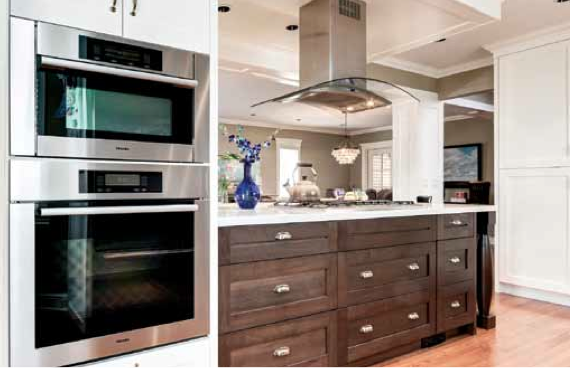Whether involved in an existing kitchen renovation or designing a new kitchen it can be very overwhelming for our clients. It is definitely a process and breaking it down will become more manageable resulting in an enjoyable experience and fulfilling your client’s expectations. As a designer, I have worked on many kitchen projects and have been consistent in my approach. There are two key considerations which should be addressed prior to starting: the design aesthetic and the function.

Encourage your client to compile a wish list along with an inspirational file to help them explore their style. This exercise helps to determine if they want their kitchen to be contemporary with modern clean lines, traditional with architectural detailing, rustic which is warm and casual or perhaps industrial with a commercial kitchen appeal. There are clients that want to showcase their appliances to achieve that “WOW” factor. For example, an industrial kitchen may boast a three to five foot professionally styled stainless steel range and hood and refrigerator with full double glass doors displaying its contents. Alternatively, for clients who want a seamless look, their fridge, dishwasher, wine cooler and ventilation can be integrated into the cabinetry. Contemporary kitchens will take this direction with built in ovens, warming drawers and microwaves that are flush with the cabinets. Another appliance that lends itself to this minimal look is the induction cook top with no visible cooking elements and now available with invisible controls when turned off. One manufacturer is introducing built-in ovens with a handless design and a colour LCD touch panel which eliminates all the hardware to further blend into the cabinetry. In addition, integrated refrigerators are now available with an internal water dispenser instead of having it located on the exterior door panel.
Once the design direction has been decided, you can then address the function. The kitchen is the nucleus of the home and serves as a gathering place for family and friends throughout different times of the day. Lifestyle is a key consideration and the first thing to address is how your client’s family operates. What activities do they perform in the kitchen, what type of cooking and how often is this function performed on a daily basis and the type and frequency of their entertaining, if any.
Once you have a clear understanding of your client’s requirements you may want to consider the following appliances. Warming drawers that keep food warm until it’s ready to serve. Double built-in ovens that allow for baking a pie while at the same time the roasting of the main entree. If your client entertains for larger gatherings or has a larger family, then the addition of a second dishwasher will be beneficial for faster clean up. Wine coolers are available in many sizes and have single or dual temperature controls for both red and white wine plus refrigeration zones for other beverages. There is also an option available to add a humidor to the wine cooler for perfect humidity control. Coffee systems can be built-in and create perfectly brewed coffee, cappuccino and lattes and are also available with a hot water dispenser for tea. Steam ovens are gaining popularity with their combined steam, refresh, thaw and baking functions. Remember, considering your client’s cooking methods and lifestyle will determine which appliances are best suited for them. At this stage it is important to consult with your client and an experienced sales associate at one of the appliance galleries that work seamlessly with designers. This is their field of expertise and their knowledge is invaluable.
Once the appliance selection has been completed, you can then decide on their placement based on how they relate to each other relative to their function. The challenge here is to incorporate the desired appliances from your client’s wish list into your kitchen plan. Particularly in smaller kitchens, addressing the maximum performance of the appliances vs. disturbing the balance of storage and overall functionality is so important. A speed oven that offers combination cooking with a fully functional oven and microwave may be well suited for this situation. If your client loves to demonstrate their cooking skills then locating the cook top on an island may provide the perfect stage for guests to gather around and watch their meal unfold. Whether the cook top is located on an island or within cabinetry, there should be plenty of space on either side for dishes and food preparation and within close proximity to the built-in oven. The dishwasher should be close to the sink for ease in loading as well as the refrigerator for washing produce before storing. Having counter space next to the refrigerator provides a touch down area when retrieving food items.
The feeling of satisfaction when my client is ecstatic about their new space and their expectations have been fulfilled is the best. By following the process and listening to your client’s requirements you can make it happen too!
Jane Dolyny, DQ (Design Quarterly)
Jane Dolyny, principal of Dolyny Design, is a residential interior designer with more than 20 years experience. She also has worked on hospitality and corporate design. jane@ dolynydesign.com
Connect


With over 2000 homes SOLD!
We Are the Right Choice For Your Real Estate Needs.

With over 2000 homes SOLD!
We Are the Right Choice For Your Real Estate Needs.



0 comments on “Planning kitchen appliances…”